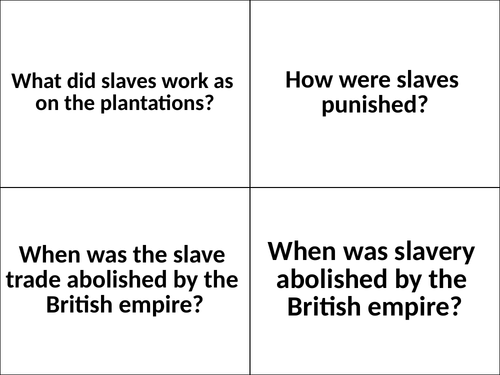








I have created a board game to teach (or revise) the Atlantic Slave Trade Triangle to KS3 students. It is a team game and works best with four teams playing at any given time. It should take no longer than 45 to 50 minutes. It works similar to that of Monopoly (you start at the beginning and make your way around to the end to see who has the most money at the end). It is an extremely interactive game and caters for all types of learners. PLEASE REVIEW!
NOTE: When printing the question cards, wild cards and chieftain cards make sure to flip pages on short edge so that the cards match up either side.
Step 1: Get your students to make a slave ship for homework - 2D or 3D.
Step 2: You can use the A4 game attachment to make the game very big that it will take up an entire classroom, consisting of a square on each table (each side of the square would be 7 tables long - see image)
OR
You can use the game that has all squares shrunk to fit on an A4 page - attachment titled The Slave Trade Triangle Game.
Step 3: Break your class into 4 teams or you can decide to have two students play head to head.
Step 4: Each player must have a Slave Ship which will represent their player piece.
Step 5. All the ships start at the beginning and role the dice to see how many moves they make. Each player must stop at every square that has a star.
Star 1: Where students decide what manufactured goods to bring. Each team gets ten coins at the start of the game. They must use these coins to buy manufactured goods (each manufactured good is worth 1 coin)
Star 2: This is where the students pick a random chieftain (out of 4) and see how many of their manufactured goods the chieftain is interested in. For every manufactured good they have that the chieftain wants they get a slave.
Star 3: This is where the students trade their slaves for manufactured goods. Two crates of manufactured goods is worth 3 coins.
Step 6: The first team/person who completes the journey gets a bonus two points.
Step 7: Once every player has reached the end line all the tallies are counted up to see who had the most successful trip.
If the player/team rolls a 3, 5 or 6 they must pick a WILD CARD and follow the instructions.
If the player/team lands on a question mark they must answer the question correctly or they will have to skip their next go.
The teacher of the class can act as the Iron Bank who keeps records of everything that happens throughout the game and makes sure nobody is cheating!
Something went wrong, please try again later.
This resource hasn't been reviewed yet
To ensure quality for our reviews, only customers who have purchased this resource can review it
Report this resourceto let us know if it violates our terms and conditions.
Our customer service team will review your report and will be in touch.